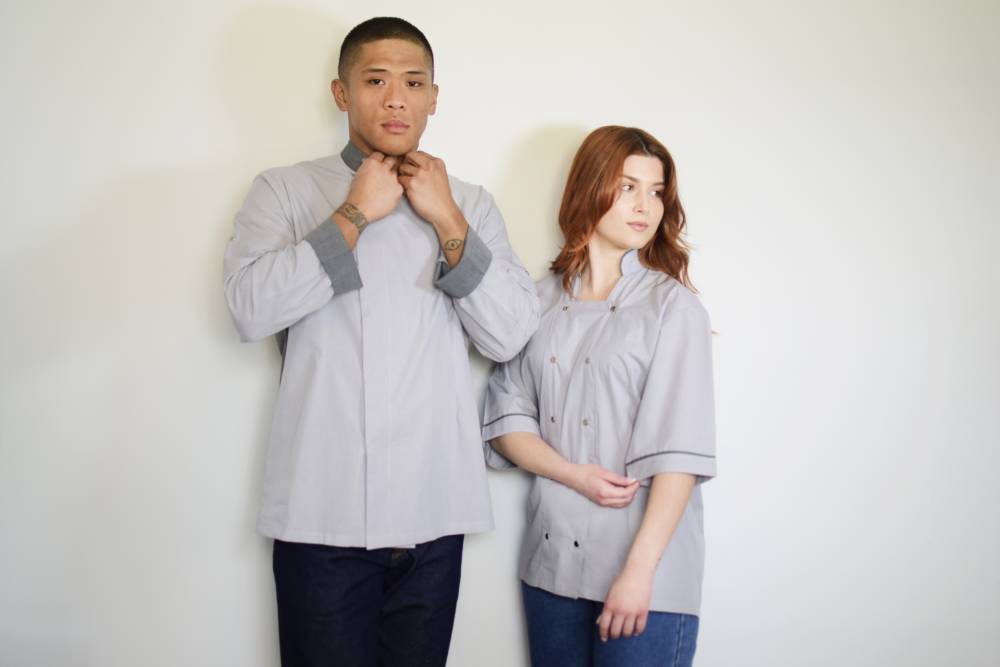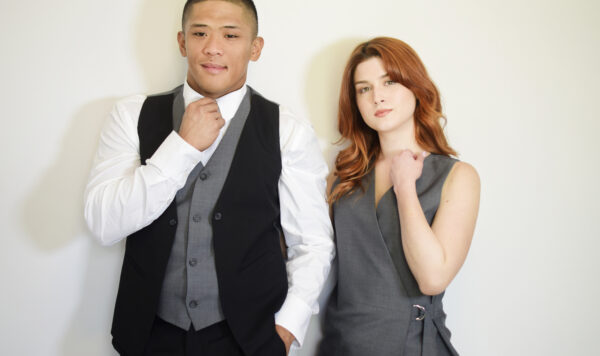In the hospitality industry, it’s all about the details. The right professional workwear and uniforms enhances brand presence as well as make employees comfortable, confident, and ready to deliver excellent service. Professional uniforms in 2025 are still evolving, where functionality and design that speak to the very essence of every brand converge.
1. Sustainable Materials
Sustainability is no longer a trend — it’s a norm. In 2025, hospitality brands increasingly draw upon sustainable materials like organic cotton, recycled polyester, and bamboo blends. They’re not only reducing environmental impacts but also offering breathability, durability, and a slim profile that appeals to conscious consumerism.
The rise of Eco – Friendly Uniforms
As the environment becomes more widely understood, so the demand for green uniforms in the hospitality industry is growing. More companies are choosing apparel made from renewable resources, low-carbon dyes, and ethical production methods. This shift reflects a broader ethos of corporate responsibility, and an expanding appeal to environmentally conscious guests and employees alike. The green uniform is no longer an alternative — it’s the new standard in the sector.
Benefits of Sustainable Fabrics
Sustainable materials offer more than eco-benefits — they are lightweight, breathable, and long-lasting and are ideal for dynamic hospitality spaces. A forward-thinking hospitality uniform provider understands that comfort and functionality need to go together with environmental design, offering uniforms that serve people and the planet as well.
2. Customization and Personalization
Customization is becoming a key trend in hospitality uniforms, with businesses looking to create unique, tailor-made looks for their employees. With custom embroidery, unique color schemes, or tailored fits, bespoke uniforms ensure that businesses stand out and sell their brand. This shift towards custom uniform services signals an increased need for workwear that combines individuality and professionalism.
The Demand for Unique Uniforms
Businesses are increasingly seeking custom uniform services to provide their staff with unique, personalized workwear that aligns with their brand. Workwear for professionals is evolving, as companies look for uniforms that offer both functionality and a distinctive style that reflects their identity.
Technologies Enabling Customization
Technology is bringing custom uniforms to the center stage. With 3D design software, digital embroidery and printing, these technologies allow businesses to manufacture uniquely customized, durable uniforms quickly, making custom uniform services cheaper and convenient.
3. Athleisure Influence
The line between workwear and activewear only narrows further, especially in the hospitality industry. In 2025, the trend of athleisure is more pronounced than ever before, with stretch fabric, breathable fabrics, and comfort-fit uniforms. The trend represents a shift towards comfort and ease of movement, allowing employees to remain neat while comfortable throughout an extended shift.
Comfort Meets Style
As a result of the athleisure trend, modern hotel front desk uniforms is now focusing on designing clothing that is both fashion-forward and comfortable. Stretch fabrics, sweat-wicking textures, and streamlined sport-inspired silhouettes are now common, resulting in a professional look without sacrificing mobility. In doing so, not only do employees present a professional appearance, but they are also comfortable throughout work hours.
Key Athleisure-Inspired Pieces
Athleisure-style uniforms are now revolutionizing hospitality uniform dress codes. Leading pieces are slimmed-down contemporary polo shirts made from technical fabrics, zip-up tops that blend functionality with streamlined design, and movement-designed tapered pants. These items bring a sporting element to traditional uniforms, offering flexibility, breathability, and a fresh, clean silhouette that is suited to modern-day busy workplaces.
4. Bold Colors and Patterns
Neutral shades can be ageless, but 2025 is all about making statements. Hospitality uniforms take bold colors and striking patterns to express brand personality and leave lasting guest impressions. Deep emerald greens to graphic prints, bold design selections elevate teams while adding flair and life to the workplace.
Making a Statement with Vibrant Designs
Uniforms are becoming a platform for bold self-expression. Bright colors, graphic prints, and unexpected combinations are now being used to convey a brand’s personality and energize the workplace. Not only do these dynamic designs get noticed, but they also help create a memorable, cohesive look for hospitality personnel.
Balancing Boldness with Professionalism
To prevent bold designs from overwhelming the professional appearance, balance is crucial. Pairing bold accents with neutral background colors, limiting bold patterns to specific uniform pieces, or using clean tailoring can keep the overall look sharp. The goal is to express personality without compromising the brand’s image of professionalism.
5. Smart Fabrics and Technology Integration
As technology revolutionizes the hospitality industry, uniforms are getting a high-tech upgrade as well. Smart fabrics that offer temperature regulation, moisture wicking, and even antibacterial properties are becoming more common. Such high-tech uniforms improve comfort, hygiene, and performance — enabling staff to stay fresh, alert, and concentrate on delivering excellent service.
Smart Fabrics
Smart fabrics are revolutionizing hospitality uniforms with their technological advancements that offer comfort and functionality. Moisture-wicking material, temperature control, and even UV protection integrated into the fabric are now de rigueur for those lengthy shifts. Such high-tech fabrics allow staff to stay comfortable and alert, regardless of the environment, and are therefore a smart investment for hospitality uniforms in 2025.
Examples of Tech-Enhanced Uniforms
Technology-enabled uniforms have fabrics that regulate body temperature, which keeps the personnel comfortable irrespective of the weather. Moisture-wicking and antibacterial fabrics are also common, offering extra comfort and hygiene. Such features assist workers in staying focused and giving their best even during extended shifts.
6. Gender-Neutral Designs
Gender-neutral uniforms are increasingly in vogue in hospitality as businesses embrace inclusivity and equality. Such designs are driven by function, comfort, and fashion, independent of gender rules. Having uniforms that work for all employees, regardless of gender, helps to create a more inclusive workplace culture and shows a brand’s commitment to diversity.
The Shift Towards Unisex Uniforms
The trend for unisex uniforms is transforming the hospitality industry with more practical and inclusive clothing. These designs prioritize comfort and use, free from traditional gendered styling. There are now unisex chef uniforms cuts to suit any shape, allowing cooks and kitchen workers to move freely without sacrificing a professional appearance. This aligns with the growing focus on diversity and equality in the workplace.
Stylish and Functional Gender-Neutral Options
Gender-neutral uniforms are a blend of fashion and convenience, with pieces like fitted tops, stretch chinos, and adjustable aprons that fit all bodies. Like, chef uniforms with ease-of-movement cuts and adjustable waistbands provide comfort and a professional look, perfect for any employee.
7. Vintage and Retro Styles
Retro and vintage-inspired looks are a powerful resurgence in hospitality uniforms. Drawing inspiration from traditional forms, retro colors, and timeless elements, the designs add character and playfulness while honoring a brand’s history. The result is an elegant combination of old and new that is both familiar and fresh.
Nostalgic Trends in Modern Uniforms
Retro uniforms are returning to vogue, with contemporary designs within the hospitality industry taking cues from them. Classic styles, such as structured blazers, high-waist trousers, and aged prints, are being reinterpreted to produce a retro look to add a retro touch to traditional workwear. These retro-inspired uniforms give a timeless look while adding personality and charm to the workplace.
Modernizing Vintage Styles
To present traditional designs with a contemporary feel, companies are incorporating new fabrics, sleek silhouettes, and refined design alterations. Traditional-style chef uniforms, for example, may possess traditional silhouettes but aerated, high-functioning fabric and contemporary elements like concealed zippers or minimalist trimmings. This combination of old and new imparts the uniforms an eternal classic appearance while ensuring comfort and functionality.
8. Minimalist Aesthetics
Minimalism is becoming a significant trend in hospitality uniforms, focusing on simplicity and refinement. Clean lines, neutral colors, and discreet ornamentation create a professional and refined look that avoids clutter. Such a trend does not only render uniforms aesthetically pleasing but also practical because they are easily adaptable to diverse workplace environments.
The Appeal of Clean and Simple Designs
The minimalist aesthetic in uniforms is all clean, plain designs that exude professionalism. With fewer elements to divert, simple-cut, neutral-colored uniforms, and understated branding create a streamlined, timeless look. Aesthetically pleasing as they are easy, these designs offer with which to attain a silky, cohesive look in any hospitality setting.
Enhancing Brand Image with Minimalism
Minimalist uniforms assist in projecting a brand’s image in an elevated manner by providing a clean, professional appearance. Uncomplicated designs and high-quality materials convey sophistication and professionalism, enabling the brand’s identity to be reflected clearly, making a lasting impact on customers and employees alike.
9. Seasonal Adaptability
Seasonal flexibility is one of the latest trends in hospitality uniforms, and more companies are now producing uniforms that adapt to the seasons. The use of light materials for summer and layering pieces for winter ensures the comfort of uniforms year-round. With this, workers are made comfortable and presentable irrespective of the time of the year, enhancing overall performance and job satisfaction.
Designing for Different Seasons
Seasonal flexibility in planning uniforms means that employees are comfortable all the time. In hot summer seasons, wicking material is used to promote air movement, and in winter seasons, layered items like jackets or cardigans are added for warmth. This flexibility not only enhances comfort but also keeps one professionally and stylishly dressed throughout the year.
Examples of Adaptable Uniform Collections
Adjustable uniform collections are designed to meet the demands of different seasons and climates. For example, spa uniforms, for example, employ light, airy fabrics in warm seasons but offer layered options like gentle jackets or cardigans for cold weather. The collections are designed to keep employees warm and stylish, whether they are working in a warm, sunny environment or in a cooler, temperate environment. The flexibility of the uniforms is also enhanced with being able to mix and match pieces.
10. Cultural Inclusivity
Sensitivity to culture is becoming the norm in hospitality uniform design. Business firms are now creating uniforms that are culturally sensitive to local culture, religion, and other identities. This is not only advocating equality and comfort but also displays a company’s commitment to creating a respectful and inclusive workplace for all employees.
Embracing Diversity Through Design
Respectful cultural and religious sensitive uniforms build a harmonious workplace. By changing designs to suit the local beliefs and tradition, the companies enable the workers to feel comfortable and valued and yet be able to present their identity while looking professional.
Benefits of Culturally Inclusive Uniforms
Culturally sensitive uniforms improve staff comfort and job satisfaction. If workers sense that their cultural beliefs are being considered, they are more comfortable and satisfied, leading to better workplace climate and performance.




